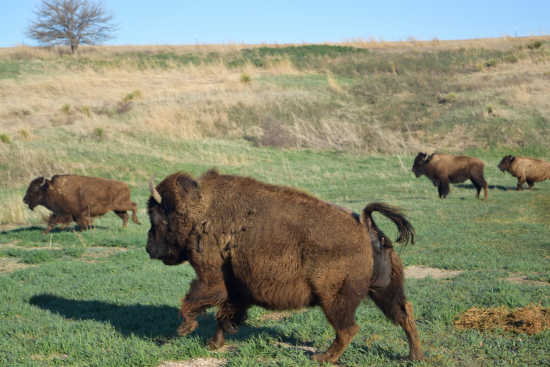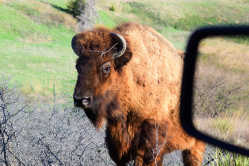Bison in new home near Hugh Butler Lake

McCOOK, Neb. -- The newest "permanent residents" near Hugh Butler Lake north of McCook were released this morning from their corral of the last six weeks into a pasture north and east of the lake roads.
When the corral gate swung open shortly after 8 a.m. today, seven American bison sniffed the ground for just a second or two and then bolted for the hills, kicking up their heels and snorting through the prairie grass and plum thickets.
Darrell Meister of Honolulu, Hawaii, formerly of McCook, and his local partner, Randy Woitaszewski of McCook purchased the one heifer and five cows, each between 6 and 7 years old, from Jerry Kautz of rural Culbertson, and the young bull from Sandhill Crane Trust.

Meister said that this herd will be "the permanent residents" in the pastures sectioned off near the lake.
Meister owns 160 acres at the lake turn-off on which to operate his bison project.
A small herd of corriente heifers, purchased from Garrett Nokes of McCook, has inhabited a 15-acre pasture nearby since March 3, and they will run with the bison this summer, Meister said. The corrientes will be bred to one of Rob Spencer's Black Rose Angus bulls (of rural Culbertson) in August and sold as bred heifers in October, providing the bison project with a cash product.
Meister said that bison breeder Ken Klemm of Goodland, Kansas, runs his bison and corrientes together and will buy Meister's bred corrientes.
Dylan Ruppert of rural McCook seeded native grasses and forbs into two former wheat fields along Highway 83 in January, and the herd of bison will have access to that new pasture when it becomes established after two to three years. Meister said he bought the native seed mix from "Prairie Legacy," owned by Kay Kottas, a University of Nebraska professor and botanist.
Meister spent Thursday planting trees and shrubs along a trail that borders the newly-seeded fields.
Dave Ruppert is growing corn in an 85-acre field west of the bison pasture, and after harvest, the corn stubble will provide winter feed for the bison herd, Meister said. They'll be supplemented if it's necessary, he said.
Meister said that the pasture fencing was built by Triple C Fencing of rural McCook, and that Bradley Machine and Pump Repair of McCook created the water system. Dr. Wayne Watkins of Red Willow Animal Clinic will provide veterinary services for Meister's herd.
Meister is pleased that he has been able to involve local residents in his bison project. "I'm very grateful for all this help, for the community involvement," he said.
